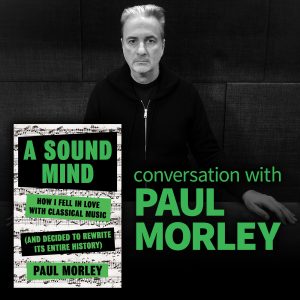By Paul Morley (Bloomsbury Press) 2020
Ever since I picked up issues of New Musical Express as a teenager and young adult, I have been drawn to the music-obsessed mind of Paul Morley. There are two types of music writing—the facts, such as who did what, and why, and where. Then there are writers like Ian Penman and Paul Morley. They use music as a springboard to investigate their world through a particular artist or album. Morley is famous for his various essays and interviews with the post-punk world of Factory Records and being a member of the band "Art of Noise." He co-started the label with mega-producer Trevor Horn and his wife, Jill Sinclair ZZT (ZANG TUMB TUUM) Records that produced (in the truest sense) Frankie Goes To Hollywood, among other artists.
"A Sound Mind: How I Fell in Love with Classical Music" is a 600-page book focusing on Morley's love for music in its representative state as well as the aural pleasures that music brings to a soul. The book is not about classical music or music in general, but more about how Morley feels and thinks about how music is such an essential practice. Morley's book is a relative of Alex Ross's excellent music study, "The Rest is Noise: Listening to the Twentieth Century." While reading" A Sound Mind," I often find myself thinking about "The Rest is Noise." Alex Ross is very much an opinionated music historian. Still, he deals with the facts, dates, and how the music has affected the modern world. Morley's approach is personal, with touches of memoir-like writing, and of course, his past (and current) world as a commentator on Pop Music. Also, both writers have a large platform to write. The reader can devour the words and makes a perfect entranceway to the classical music world. Still, Morley doesn't always go from A to Z.
The Classical world, generally speaking, is very boxed-in culturally. Musicians in that domain often specialize in a few composers or focus on a particular movement in history. The great pianist (and thinker) Glenn Gould specializes in Bach, Beethoven, Brahms, Handel, and explores the world of Paul Hindemith. In comparison, some musicians focus on Debussy, Ravel, and others' Impressionistic music, and others, only contemporary music such as David Tudor. In Morley's mind, he doesn't know why one can't have both Mozart and John Cage on one album. His aesthetic and thinking are very much against music categories that are separated by history or specific movements. As a listener, he wants to digest the music in his manner or way.
I have a healthy curiosity, and I like to approach art as something that I don't know, a mystery to me that will lead me to a journey with great possibilities. Morley feels the same way. His writings deal with the sense of discovery and wonder when approaching an artist or world; he is not sure about or even fully aware of their greatness. In the most real sense of a critic, he's not here to say so-so is bad or good, but why they do demand attention from the listener.
Morley is not a dot connector but does give direction in how classical music moves from one century to another. It's just not all Bach, Brahms, and Beethoven here, and there is only a touch of Wagner (for that one needs to read Alex Ross's "Wagnerism."). Before I read this book, I never knew that Wagner wrote Siegfried Idyll as a surprise for his wife to be played for her birthday. Initially, the music was made for a thirteen-piece orchestra to be played outside of her bedroom. Or that Ruth Crawford Seeger (1901-1953), a rare female modernist in classical music, is also the stepmother to Folk legend Pete Seeger. She is mostly known as a folk-song collector and transcriber. Still, according to Morley, she wrote one of the great pieces in the post-twelve-tone American modernism. Also, Morley writes in great excitement on Elizabeth Maconchy (1907-1994), who wrote and was electrified by string quartets. In her liner notes for The Complete Quartets Vol. 1: String Quartets Nos 1 -4, "the string quartet is the most satisfying medium of all." A contemporary of hers, Elisabeth Lutyens (1906-1983), was looked upon as England's 'first serialist’ and nicknamed Twelve-Note Lizzie. She was from a wealthy family in England. Jiddu Krishnamurti even lived in their family home, as the Lutyens clan were interested in the Theosophical Movement. Her String Quartet No. 6, Op. 25 (1952) is six-minutes and five-seconds of moodiness as a practice. Her side job as a composer was writing music for British horror films such as Dr. Terror's House of Horrors (1965).
The majority of music geeks that I come upon have a strong preference for vinyl or CD, but Morley seems to be okay with the streaming world. Fan of the vintage Walkman as well as Spotify (although not necessary for the musicians and composers being ripped off by the company). He loves the idea that one can take their music anywhere, as well as obtaining any music one can wish for. More importantly, he can break out of the Classical world's conservatism by programming two different music types from different decades or styles. There is a format that is strict when one approaches the classical music market. Also, musicians tend to have specific expertise of a particular century or style, such as Romantic or Impressionistic music. Morley, in the book, writes about and interviews musician Joanna MacGregor, a pianist. The latter has recorded and performed music by John Cage to Bach and worked with Talvin Singh. Her first music hero was Marc Bolan, and from there, she went to the score of classical music composers. MacGregor's extensive repertoire of music she covers is anti-elitist and open to a wide selection of music in that world. She's a rarity for a classical orientated pianist to be so vast in presenting music to an audience. As a listener, Morley enjoys the essence of a musician's journey into music.
"A Sound Mind" also touches on someone like Brian Eno and how he has a presence in the composer's landscape. From 1975 to 1978, Eno started a record label, Obscure Records, that focuses on mostly Avant-Garde composers such as David Toop (a marvelous writer), Gavin Bryars, Michael Nyman, Harold Budd, John White, and a few Americans such as Cage and John Adams. Eno recorded Discreet Music for his label as well. For a rock/pop fan such as Morley and yours truly, these albums were influential in that they opened a pop music fan to different and more 'obscure' music.
As a casual listener of Classical Music, I know the B's - Bach, Brahms, Beethoven, and even a Wagner or Satie, with Debussy on the side. However, there are still many composers whose music I don't know and composers I have never heard of. Morley takes the reader on a journey as he's the tour guide and drives the van. A Sound Mind is an exceptional entrance to a world that I really don't know too much about, and I (and like Morley) come from the world of Rock n' Roll. Morley even went to the Royal Academy of Music to study how to write a composition and read music. His curiosity is addictive, and Morley's methods of exploring the unknown world of the Classical Music world is a fascinating trip and read.
-Tosh Berman








































